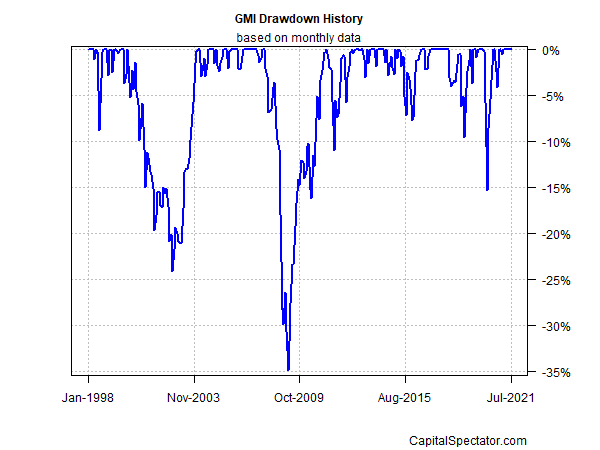Major Asset Classes - Risk Profile, July 2021
An extraordinary run of low risk persists for the Global Market Index (GMI), an unmanaged, market-value-weighted portfolio that holds all the major asset classes (except cash). After the benchmark posted another monthly gain in July, risk-adjusted performance ticked higher once again.
GMI’s 10-year Sharpe ratio (SR) edged up for a fifth straight month to 0.86, the highest since January 2020, based on a rolling ten-year window via monthly data. A Sharpe ratio of 1.0 equates with return matching risk (return volatility) and higher (lower) Sharpe ratios indicate higher (lower) risk-adjusted performance.

Profiling GMI through a drawdown lens also reflects an extended stretch of low risk. For a sixth month in row through July, GMI’s peak-to-trough decline has been zero, courtesy of the index’s ongoing rally to new highs.

GMI represents a theoretical benchmark for the “optimal” portfolio. Using standard finance theory as a guide, this portfolio is considered a preferred strategy for the average investor with an infinite time horizon.
Those assumptions are, of course, unrealistic in the real world. Nonetheless, GMI is useful as a baseline to begin research on asset allocation and portfolio design. GMI’s history suggests that this benchmark’s performance is competitive with active asset-allocation strategies overall, especially after adjusting for risk, trading costs and taxes.
For additional context, readers can use this basic risk profile for GMI alongside the current monthly updates on performance and expected return for the benchmark and its components.
The table below presents additional risk metrics for GMI and its underlying asset classes, based on a trailing 10-year window through last month.

Here are brief definitions of each risk metric:
Volatility: annualized standard deviation of monthly return
Sharpe ratio: ratio of monthly returns/monthly volatility (risk-free rate is assumed to be zero)
Sortino ratio: excess performance of downside semivariance (assuming 0% threshold target)
Ulcer Index: duration of drawdowns by selecting negative return for each period below the previous peak or high water mark
Maximum Drawdown: the deepest peak-to-trough decline
Beta: measure of volatility relative to a benchmark (in this case GMI)
Disclosures: None.



